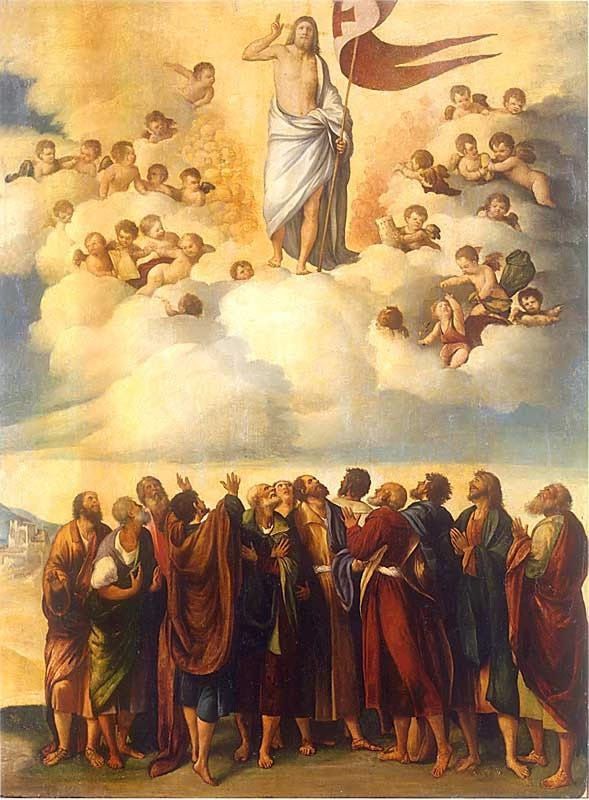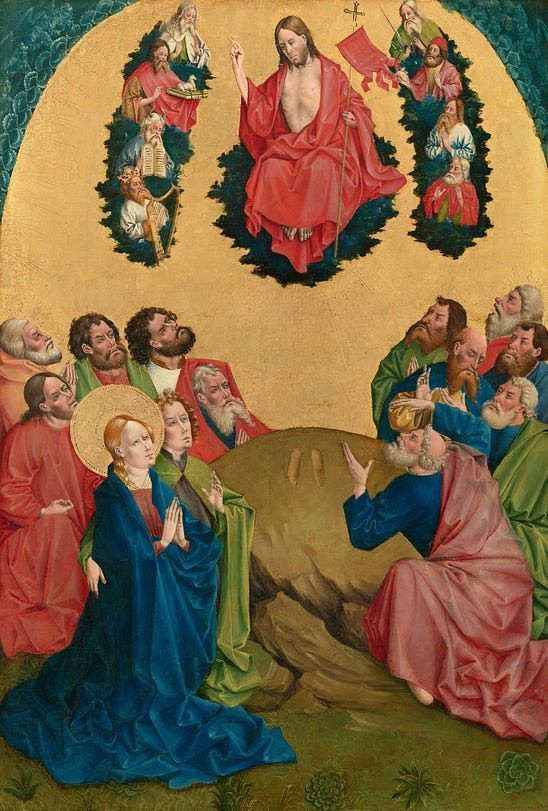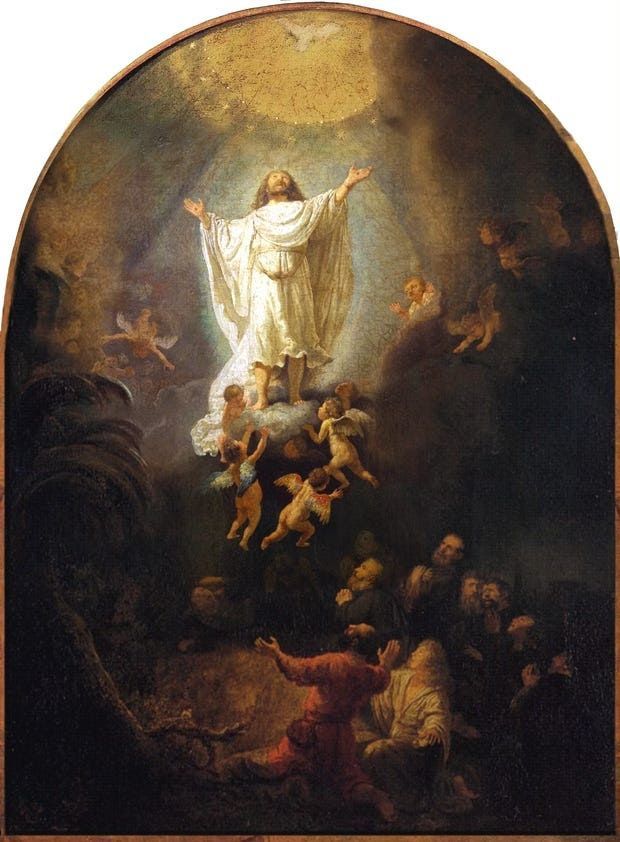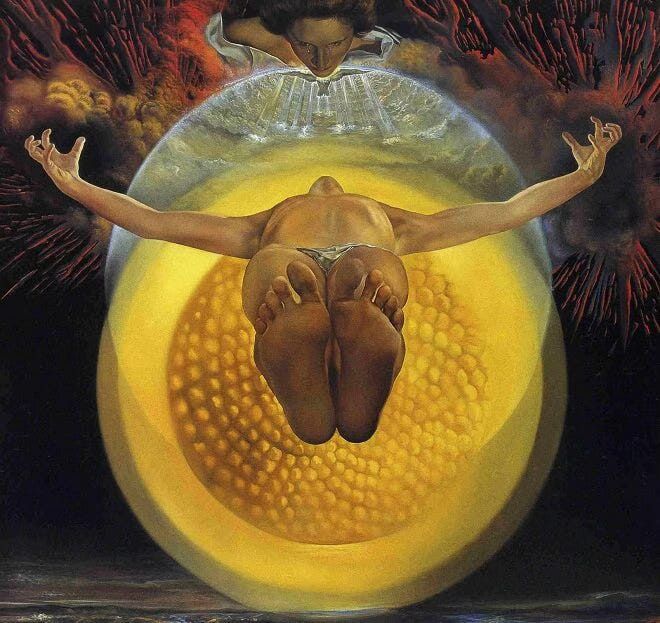Eclipses, Northern Lights, and the Artwork of the Ascension of Christ
This question seems out of place in a story we call The Ascension. If something extraordinary happens in the clouds, we will look up. We watch when the sunset moves from burned orange to a bloody red plunge over the horizon. All activity stopped this April to watch the total eclipse of the sun. We have flooded our Facebook feeds with marvelous purple Northern Lights.
If you are a headline writer summarizing the meaning of Acts 1:1-11, you would likely lead with something about Jesus ascending into the clouds. Isn't heaven the focal point of action? Imagine, during the eclipse, just after the sun has re-emerged from darkness and full daylight returns, two angels appear and say, "People of New England, why are you looking at the clouds?" It seems incongruous, so what should the disciples think as Jesus is taken up into heaven?
This morning, we will explore how this scripture pushes us to translate heavenly wonder into earthly vision. We are encouraged beyond a heavenly gaze of awe to become empowered by God's Spirit. I will explore how Luke's story moves us from the life and actions of Jesus to the Acts of the Apostles. The emphasis moves to the Holy Spirit guiding and working in us.
I will also use some Ascension paintings to stimulate your thinking. Look at Dosso Dossi's painting of The Ascension from the Renaissance in the 1530s.

Jesus waves like a conquering hero and plants a flag in heaven, just as European explorers like Columbus are doing all over the Americas. Jesus discovers heaven! Note he is wearing a Roman toga, which seems highly unlikely given his death on a Roman cross. In Dossi’s day, people are still debating if the world is flat, and Galileo and the telescope are nearly a century in the future. Heaven is where the power is and faith is all about getting to heaven. As we read Acts, the Dossi Ascension missed the point.
Acts begin after the Risen Christ appears to people for 40 days. Jesus is giving his last instructions, that the disciples wait for the Holy Spirit to come upon them. Naturally, they want to know what that means regarding the plan. "Lord, is this the time when you will restore the kingdom to Israel?" they ask. This question is about power and authority. Surely, if Jesus conquered death, now he would conquer Rome and finally set up his Kingdom. They might also wonder what role they will each have in the new Kingdom. Am I going to be Treasury Secretary or Education Secretary? To paraphrase Jesus, he says, "My work in this realm is done. You will wait for the Holy Spirit to come among you, just as John the Baptist promised, and take it from here." Luke says that Jesus is lifted up, and a cloud takes him out of sight.
This scene is a very abrupt leadership transition. The pastor says, "I'm leaving; the Holy Spirit will guide you," then she rides the clouds into the sunset. The disciples would like some kind of ceremony where one gets a crown on their head. Or Jesus touching a sword to each shoulder to signify the torch has been passed. But there is no crown, torch, sword, or even an honorary degree. “Wait, and the Spirit will come upon all of you.” All of us, really? Even Bartholomew because I don't think he's ready for leadership? Luke shows the disciples will be a radically different community than Roman society. It will not run top-down because God's Spirit will empower everyone to carry on the work of Jesus. The rest of the book of Acts will show us how the Spirit works.
The disciples are left stunned, gazing into the empty clouds. Before they can jockey for leadership or figure out new bylaws, two angels in white come and say, "Why are you looking into the clouds? Jesus is gone, and he will come back the same way." Some people take this literally and think Jesus will again come from the clouds, but it can also mean the presence of Christ will show up and surprise us at times when we don't expect it.
Let's look at a second painting by Johan Koerbeck from the mid-15th century.

Jesus looks less triumphal and more like he is saying goodbye. The golden aura encompasses everyone, and Jesus holds a shepherd's staff and makes the sign of peace. What got my attention was the rock below. Jesus has left two clear footprints on the rock of the Mount of Olives. Footprints keep the action on the human plane rather than in heaven. The painting beckons us to follow the path. Walk in the steps of Jesus. Koerbeck is more faithful to Jesus message to wait for the Holy Spirit to guide and empower them. Don't just look to heaven for relief, but watch for the guiding footprints on Earth.
Next is Rembrandt's dramatic painting from the 1630s.

He portrays the Ascension as the light of heaven breaking through the human darkness on Earth. Christ's eyes look to the dove, a symbol of the Holy Spirit; the dove that visited at Jesus's baptism is now coming down from heaven. Rembrandt faithfully captures the meaning of Acts 1. As Jesus ascends, the Holy Spirit descends to enlighten human action on Earth to overcome the darkness. Rembrandt also foreshadows the beginning of the philosophical Enlightenment of the 17th century. He begins this painting just months after Galileo has been found guilty of heresy for suggesting the Earth orbits the sun. Galileo's popularization of the telescope enabled humanity to start exploring the night skies. We discovered that the moon is a rock, Saturn has rings around its circumference, and no cherubs or angels are visible in the heavens. People began to wonder where God was, and the Roman Church quickly shut down scientific exploration of creation. I wonder if Rembrandt's Ascension was saying this is the moment of a new enlightenment. This rise of science and new understanding of the world brings humanity out of darkness, and the Holy Spirit guides the quest. We don't have to fear the pursuit of knowledge.
The last painting to view is from Salvatore Dali's Ascension for the Nuclear Age.

New Paragraph





